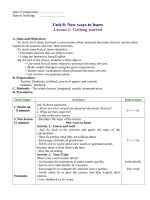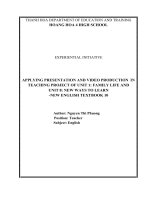English 10 UNIT 8 NEW WAYS TO LEARN COMMUNICATION AND CULTURE
Bạn đang xem bản rút gọn của tài liệu. Xem và tải ngay bản đầy đủ của tài liệu tại đây (1.45 MB, 23 trang )
Watch a video
- Group A remember all the advantages of
electronic devices.
- Group B remember all the disadvantages.
- After that one student from each group goes to
the board and writes down your answers.
Should students be allowed to use
electronic devices in classroom?
COMMUNICATION &
CULTURE
I. VOCABULARY
- concentrate on /'kɒnsntreɪt/ (v.phr): tập trung
to give all your attention to something and not think about anything
else.
- permanent /'pɜ:mənənt/ (a) ≠ temporary /'temprəri/ (a):
vĩnh viễn
tạm thời
- radiation /reɪdi'eɪʃn/ (n):
sự phóng xạ
- harm /hɑ:m/ (v): gây hại, có hại
E. g: Radioactive rays could harm your body and environment.
- look up (v.phr): tra nghĩa
- survey (n): sự khảo sát, cuộc khảo sát
(v): khảo sát
I. COMMUNICATION
Activity 1: Read the following comments on personal electronic
devices. Which sounds most reasonable? Why?
I. COMMUNICATION
Activity 2: Exchange your opinions on using electronic devices in
class. Refer to the comments in Activity 1 if necessary.
* Useful language:
Expressions to give opinions
- We think / believe…
- In my opinion/ For me….
- Personally,…
*Example:
We think / In my opinion/ For me we can use
electronic devices to look up information.
II. COMMUNICATION
Activity 2: Exchange your opinions on using electronic devices in
class. Refer to the comments in Activity 1 if necessary.
Some ways to agree
· I couldn't agree with you
more.
· That's so true.
· That's for sure.
· You're absolutely right.
· Absolutely.
· That's exactly how I feel.
· Exactly.
Some ways to disagree
·
·
·
·
·
·
·
·
I don't think so.
No way.
I'm afraid I disagree.
I totally disagree.
I beg to differ.
I'd say the exact opposite.
Not necessarily.
That's not always true.
I. COMMUNICATION
Activity 2: Exchange your opinions on using electronic devices in
class. Refer to the comments in Activity 1 if necessary.
Example
II. CULTURE
Activity 1: Answer the questions.
1.
What do school children in the United States use electronic
devices for?
They use them to look up and store information, do the assignments
and projects, dc calculation and play games.
2. How many US children have used mobile devices before they
could speak in full sentences?
About 2 out 5 children.
3. How may the devices help very young children?
.They may help promote listening and speaking ability.
4. How may they help older children?
They may help improve their critical thinking, reading, writing and
maths skills.
5. What are the two sides of the children’s use of electronic
devices?
They can be great educational tools, but the wrong use may cause
bad effects.
LET’S JOIN A GAME!
“Pick up fruits”
Tom
Jerry
II. CULTURE
Activity 1: Answer the questions.
1. What do school children in the United
States use electronic devices for?
A. to look up and store information
B. to do assignments and projects
C. to do calculations and play games.
D. All the correct
II. CULTURE
Activity 1: Answer the questions:
2. How many percent of US children have
used mobile devices before they could speak
in full sentences?
A. 30%
B. 40%
C. 50%
D. 60%
LUCKY FRUIT
II. CULTURE
Activity 1: Answer the questions:
3. The devices may help very young
children………………….
A. promote listening
B. reading comprehension
C. writing comprehension
D. promote listening and speaking ability
II. CULTURE
Activity 1: Answer the questions:
4. The devices may also help improve older
children's critical……………………
A. thinking and reading
B. thinking and writing
C. thinking, reading, writing and maths skills
D. reading, writing, and maths skills
II. CULTURE
1. Activity 1: Answer the questions:
5. What are the two sides of the children’s use
of electronic devices?
The devices not only can be great learning
tools, but also cause very bad effects.
Activity 1: Answer the questions:
1. To look up and store information, to do
assignments and projects, to do calculations and play
games.
2. 40% ( 2 out of 5 children)
3. The devices may help very young children
promote listening and speaking ability.
4. The devices may also help improve older
children's critical thinking, reading, writing and
maths skills.
5. The devices not only can be great learning tools,
but also cause very bad effects.
II. CULTURE
Activity 2:Talk about how children in your local
area/ your country use mobile phone / electronic
devices.
*Some suggested questions:
1. How old are they when they use electronic
devices?
2. How many hours a day do they use
electronic devices?
3. Why do their parents allow them to use?
4. What can electronics devices effect to
children’s body?
II. CULTURE
Activity 2









